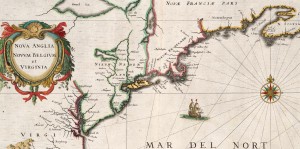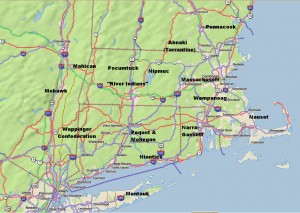اختيار لغتك لترجمة لصناعة السيارات:

المستخرجة من 1632 خريطة أمريكا الشمالية – مصدر خريطة الاستنساخ من باب المجاملة نورمان B. يفينثال مركز خريطة في المكتبة العامة في بوسطن
هذا هو الجزء 2 من سلسلة حول تأسيس نيو انغلاند. لجزء 1, الهنود الحمر, انقر هنا.
In the 1400’s, حتى قبل رحلة كريستوفر كولومبوس اسطوري ل “اكتشف” أمريكا, صياد الباسك بالصيد عادة لسمك القد في المنطقة المحيطة ما كان ليتم استدعاؤها نيوفاوندلاند. في 1497, تحت رعاية الملك الإنجليزي هنري السابع, المستكشف جيوفاني جنوة Caboto (جون كابوت), أثناء البحث عن طريق التوابل إلى آسيا, وأشار أرض مع واسعة, الساحل الصخري تعج سمك القد. دعا كابوت هذا “لاند الجديد وجدت,” وادعى لانكلترا. وبحلول أوائل 1500, كان من الشائع للغة الإنكليزية سفن الصيد لزيارة وحصاد سمك القد من هذه المنطقة.
في جهود موازية, في 1501 وصل المستكشف البرتغالي جاسبار كورتي ريال ما هو الآن في حالة من مين واختطف أكثر من 50 الهنود; بيعت الهنود في العبودية. في 1523 أبحر الإيطالي جيوفاني دا فيرازانو في ناراجانسيت خليج, بالقرب الوقت الحاضر بروفيدانس, RI, وأمضى أكثر من أسبوعين التداول كضيف من المواطنين. وبعد أن ترك ناراجانسيت, أبحر الشمال واجه Abnacki على ساحل ولاية ماين. في 1534, الفرنسي جاك كارتييه “مكتشف” واستكشاف فم القديس. نهر لورانس, مدعيا المنطقة لفرنسا. (وقد كارتييه تشارك في وقت لاحق في جهود الاستعمار, ولكن تم التخلي عن هذه في 1543.)
وبحلول نهاية 1500, قد الاستكشاف الأوروبية في أمريكا الشمالية أصبحت شائعة, ولكن كان يركز على صيد سمك القد وفيرة. لم مستوطنات دائمة لا وجود لها وذهب الصياد-المستكشفين المنزل مع اقتراب فصل الشتاء. عالميا, لاحظت أن الأوروبيين أمريكا الشمالية استقر غزيرا مع المواطنين, توصف عادة بأنها وسيم وصحية. و, بدت المنطقة مهيأة للاستغلال. بدأ الاهتمام الأوروبي للتحول إلى رأس المال أكثر منهجية في أمريكا الشمالية. وأدى ذلك إلى ظهور “الشركات التجارية” أنشئت لإقامة مستوطنات دائمة لجني الثروات.
في 1602, المستكشف الإنجليزي بارثولوميو جوسنولد أنشئت وظيفة صغيرة في جزيرة Cuttyhunk (في جزر الإليزابيثي قرب كيب كود ونيو بيدفورد), لكنه اضطر الى التخلي عن الموقع المتقدم بينما كانت مجموعة إمدادات كافية لآخر فصل الشتاء. وخلال هذه الزيارة, وينسب Gosnold مع تسمية "كيب كود" واكتشاف مارثا فينيارد. (في 1607 شارك Gosnold في تأسيس جيمس تاون, أول مستوطنة إنجليزية دائمة في أميركا الشمالية.)
في 1605, المستكشف الفرنسي صمويل دو شامبلان, المعروفة باسم مؤسس "فرنسا الجديدة" في أمريكا الشمالية, ساعد على تأسيس بور رويال, أول مستوطنة الفرنسية الناجحة في أمريكا الشمالية. في 1605-1606, زار كيب كود مع وجود خطط لإقامة قاعدة فرنسية. تم التخلي عن هذه الخطة بعد مناوشات مع المواطنين. في 1608, تأسست شامبلين ما يعرف الآن باسم مدينة كيبيك, على نهر سانت لورانس في كندا.
الانكليزي السير فرديناندو الخوانق, و “والد الإنجليزية الاستعمار في أمريكا الشمالية ", كان يخطط لتطوير المستوطنات في ولاية ماين - "وبحضور طرف واحد الشمالية من ولاية فرجينيا" ثم نظرت في 1605, كان جزءا من مجموعة الراعية للرحلة استكشافية ارسلت لاستكشاف المنطقة في نيو انغلاند تحت الكابتن جورج Waymouth. خلال رحلته, القبض على خمسة Waymouth الهنود, الذي أحضر إلى إنجلترا. وفقا لبعض الحسابات, واحدة من الهنود استولت كان Squanto – نفس Squanto الذي كان للعب دورا رئيسيا في مساعدة الحجاج البقاء على قيد الحياة أول فصل الشتاء في أمريكا الشمالية. بعد 1605, قامت العديد من الرحلات الإنجليزية احد أو أكثر من الهنود كمرشدين والمترجمين الفوريين.
في 1606, بدأت مرة أخرى عن طريق الخوانق, تسوية Sagadahoc (المعروف أيضا باسم بوفام) في قاعدة كنبك] بالقرب بورتلاند الحديثة, أصبح مين أول محاولة الإنجليزية في استعمار نيو انغلاند. تم التخلي عن ذلك بعد عام واحد فقط.
في 1609, برعاية شركة الهند الشرقية الهولندية للبحث عن الممر الشمالي الغربي التوابل, المستكشف الإنجليزي هنري الذي أقره ساحل المحيط الأطلسي وحتى النهر التي كانت تحمل اسمه هدسون. ادعى هدسون جزءا كبيرا من الأراضي بين فرجينيا ونيو انغلاند لالهولندية. أول مستوطنة لهم, للمتاجرة الفراء, أنشئ بالقرب يومنا هذا ألباني, نيويورك, في 1615. جهود الاستعمار الهولندي لم تبدأ حتى 1624, مع الأرض التي كانت لتصبح العاصمة على, نيو أمستردام, لم يتم شراؤها من الهنود الحمر حتى 1626.
في 1614, وصدر أمر الإنجليزية المستكشف الكابتن جون سميث من قبل المستقبل الملك تشارلز الأول للإبحار إلى أمريكا لتقييم الفرص التجارية. وصل سميث الأراضي في الوقت الحاضر ولاية ماين، وجعل طريقه إلى جنوب كيب كود, مما يجعل الاتصال مع المواطنين، ورسم خط الساحل. ودعا سميث في المنطقة “نيو انغلاند.”
خلال رسم الخرائط, ولاحظ سميث الأرض التي كانت لتصبح بوسطن. واشار الى ان شبه جزيرة ثلاثي توج التلال مع ميناء ممتاز. كان يتغذى على الميناء من قبل ثلاثة أنهار وتوصيلها الى البر الرئيسى عن طريق عنق ضيق عبر خليج العودة الضحلة. ودعا "Shawmut,"كان من المهم أن السكان الأصليين للحصول على المياه العذبة في الربيع ممتاز.
كل هذا تم وضع المشهد لأول مستوطنة دائمة في نيو انغلاند في 1620, رحلة الحاج إلى ما أصبح بليموث. لكن, هذه قصة أخرى.















